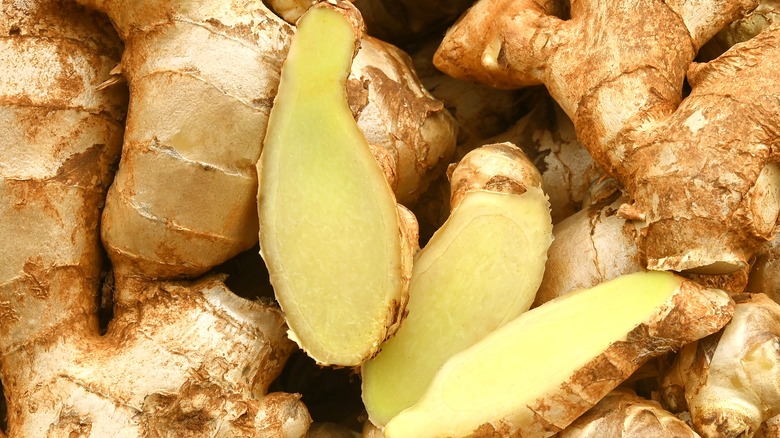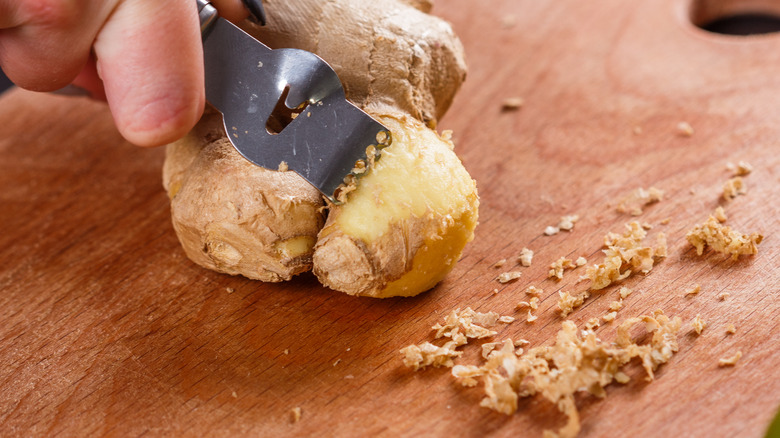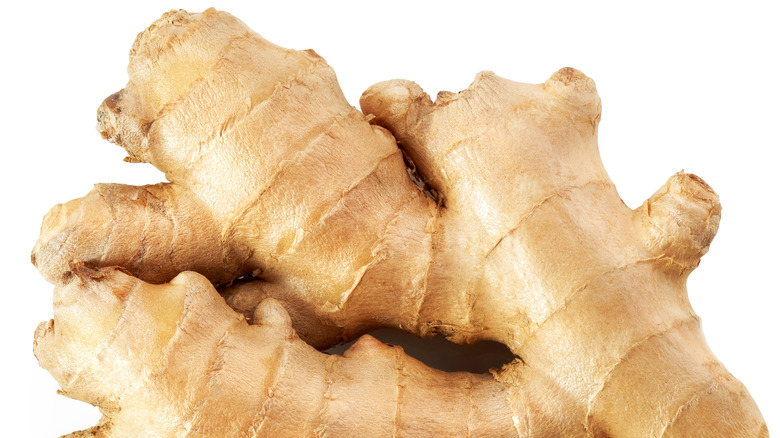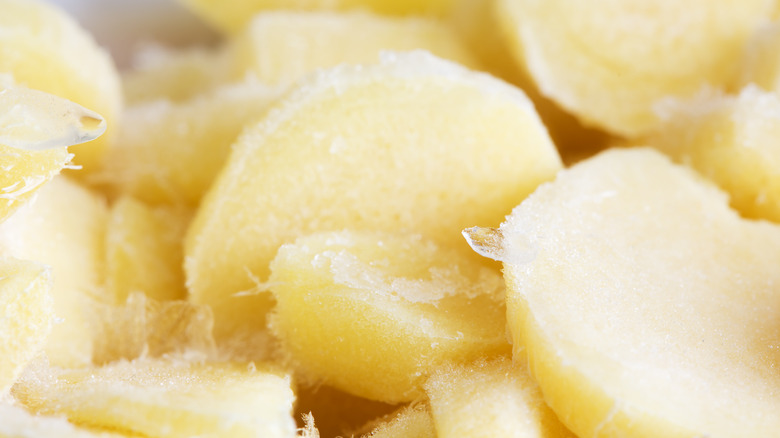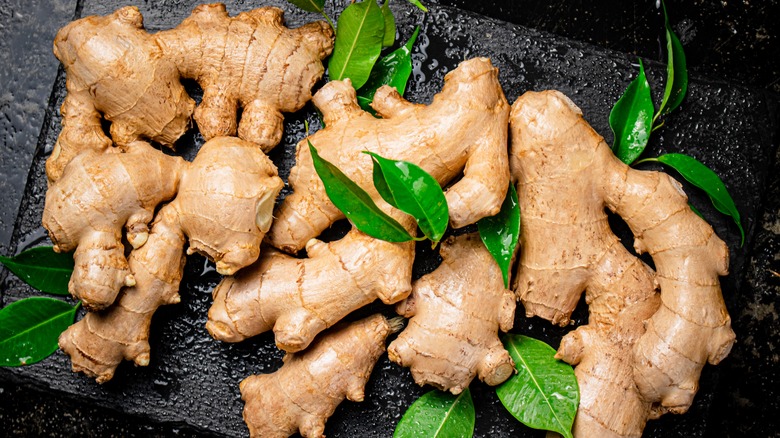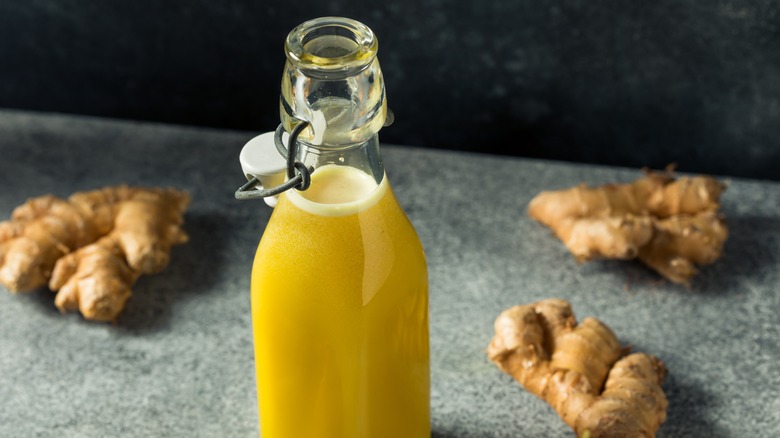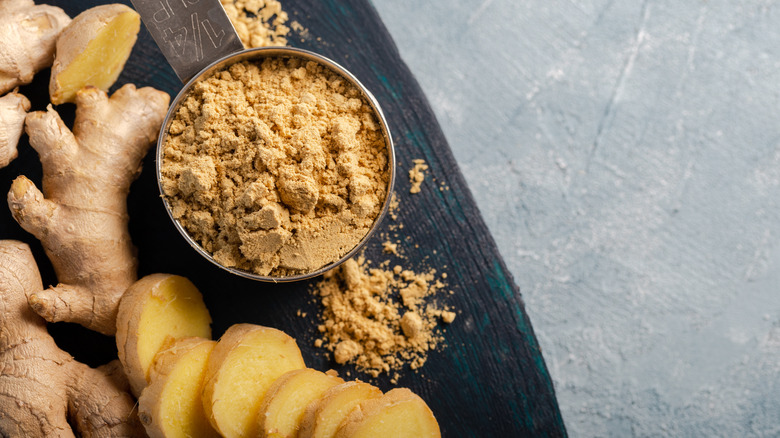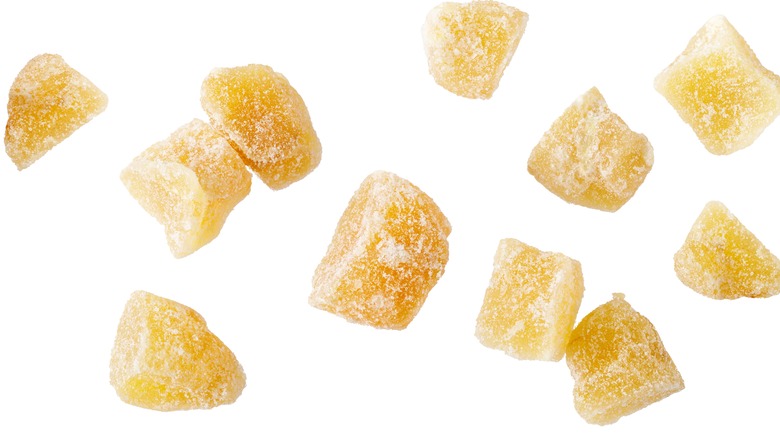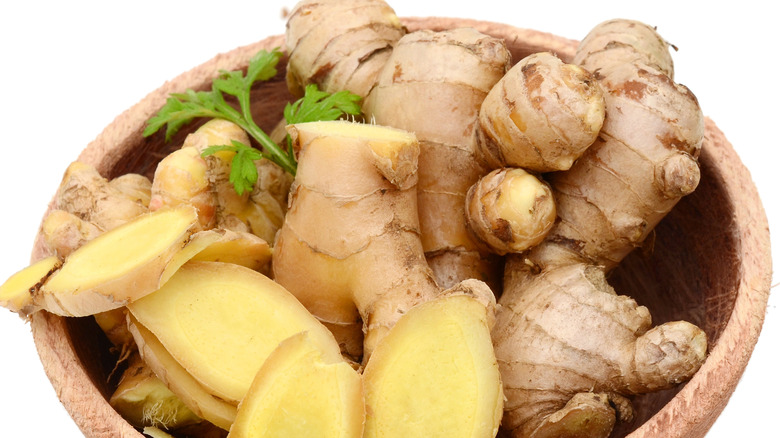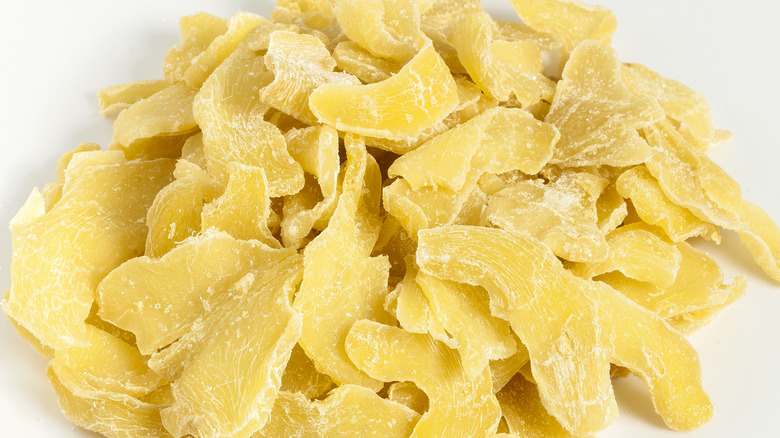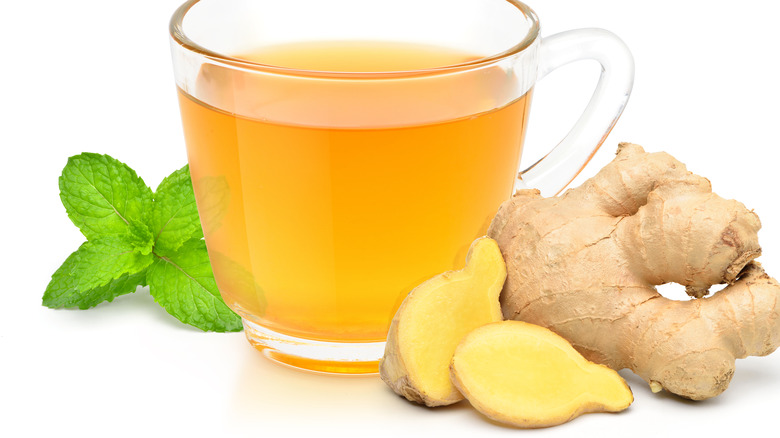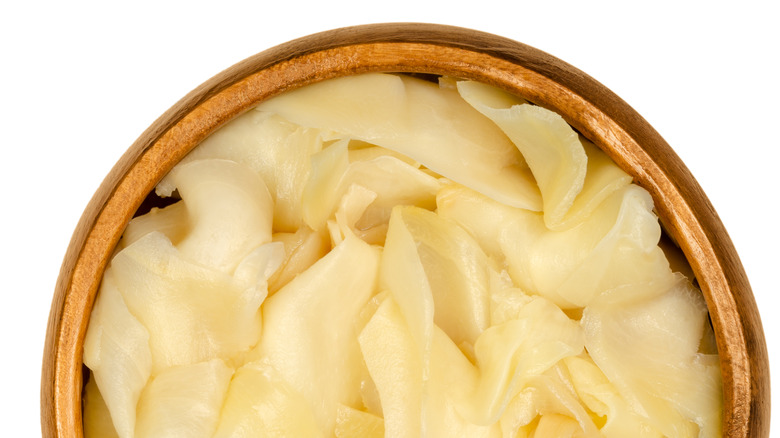14 Tips You Need For Cooking With Ginger
We may receive a commission on purchases made from links.
Ginger — the spice of life provides a splash of heat to your favorite soups, curries, and stir-fries. The pseudo-root (which is not actually the root but a plant's underground stem) has extensive use in culinary tradition. You might be surprised to know that it's been almost 4,000 years since ginger took root in kitchens around the globe. The plant was originally used in Chinese traditional medicine to "harmonize the stomach." Even in modern times, the help benefits of consuming ginger are widely recognized. Nutritional and medical research have noted that ginger has the potential to lower glycemic indices for folks with Type 2 diabetes as well as relieve the symptoms of osteoarthritis and chemotherapy-induced nausea.
Ginger can be purchased in many forms, including whole root, powdered, and crystalized, depending on the recipe you plan to use it in. Here are some of the most important things you need to know before you pick up a piece from the produce section or a container from the spice aisle.
Add your ginger at the end
According to research published in the National Library of Medicine, heat changes the flavors and composition of many ingredients. Ginger is also affected by it. One mistake people often make when cooking with ginger is adding the spice too early on. While it might be more convenient to toss your grated ginger in with the onions, garlic, and other spices, this will meld the flavor of the ginger. Fresh ginger contains gingerol, a chemical feeling that affects similar to the way capsaicin does in pepper. As food cooks, gingerol transforms into zingerone: a more aromatic, sweet-tasting chemical (via Peak Scientific). The smoothness of the zingerone is what we taste in gingerbread and other sweet applications of ginger in cooking.
If you want a particularly gingery flavor in a dish, you should add ginger towards the end of cooking. This will capitalize on the gingerol before it is transformed into zingerone. For example, if you're making a spicy curry recipe, add ginger at the same time you add the coconut milk.
Peel ginger by scraping it
If you're a ginger novice, you might pick up a piece of ginger at your store and wonder, "how the heck do I peel this?" Your first inclination may be to reach for your vegetable peeler, but soon you will realize that ginger is much knobbier than a potato or a carrot — so you'll end up hacking away at most of the ginger's flesh to get the peel off. A paring knife would not work for the same reason — plus, you probably don't want to cut off your skin in the process. The best way to peel ginger, instead, is nothing fancier than a metal spoon.
You'll need to use the edge of the spoon to scrape the skin off the root. The thickness of the root means you don't have to be afraid about breaking it, so peel as hard as you can with your trusty utensil. Once you've removed the skin, the options are endless, and you have the maximum amount of ginger root remaining.
You don't have to store ginger in the ice box
Produce goes in the fridge, right? Not ginger. One of the best ways to keep ginger fresh is to store the root on your countertop, especially if you plan to use it frequently or all at once. You don't need to wrap the root or take any special precautions to ensure its longevity in your kitchen. Like other types of produce, ginger prefers dark and cool storage.
If you notice the ends of the ginger start to harden where you made your initial cut, fear not. The ginger root forms a protective, hard seal over its exposed parts. When you go to use the ginger next, simply slice off the hard part of the root with a sharp knife before preparing. Although this method of storage will give you a few extra days of use for your ginger, consider freezing your ginger pieces for longer use — or thinking of more recipes where you can use the rest of the root in.
If you can't use a whole ginger root, freeze the rest
If you can't stand the sight of a lone piece of ginger on your counter, you should turn toward your freezer. This is the best option for cooks who want to use ginger sparingly in recipes but always want to have a bit on hand when needed. Of the reasons you should start freezing your ginger, the fact that it can last indefinitely in the freezer may be the best. However, you may notice a drop in flavor after six months. When you're ready to grate, you'll notice the root is fresher and easier to peel after it has been frozen. You can also pop the whole, unpeeled root in your refrigerator for up to a month. If the root has been cut, you should expect it to last about two to three weeks in your fridge.
To store the ginger in your freezer, place the entire piece in an air-tight freezer bag. When you're ready to use, grate the frozen ginger as you would fresh ginger. If you want dime-shaped pieces of ginger, it's best to let the ginger defrost for about 10 minutes for easier and less haphazard cuts.
A mild smell may mean your ginger has spoiled
When ginger has gone bad, the root will give off a few signs when that it's ready to be tossed in the trash. If it has gone longer than a few weeks on the counter or a few months in the fridge or freezer, you'll want to conduct a visual and aromatic inspection before using it in your recipe. The outer layer of the ginger should be papery, while the interior should be firm and yellow. Ginger that appears soft, wrinkled, or has visual signs of mold has gone bad.
If your ginger passes the visual inspection test, you will also want to take note of the ginger's smell and flavor when you use it. Ginger that is low-quality or spoiled will not be as pungent in taste or aroma, per Fresh From the Gardens. If your ginger is bland but not moldy, it is still safe to eat (though it might not be as fun). Just don't expect a bright pop of flavor in your stir-fry or cocktail.
Use a microplane grater for shaving ginger
The microplane grater is your best friend for cooking with ginger — and it's one of Ina Garten's favorite tools to have in the kitchen. The microplane grater makes quick work of ginger, citrus fruits, and garlic. According to Bake Starters, a microplane is easier to use for fine grating in the kitchen because the size of the blades results in a smoother grate than a box grater or a knife could ever offer. You'll also notice that using a microplane grater results in better consistency and is much easier to clean than a box grater. Plus, the microplane grater allows you to grate in both directions, which is not possible with a box grater.
Microplane graters can be purchased for less than $15. Our pick is the OXO Good Grips Grater for its ease of cleaning (you can just plop it in the top rack of your dishwasher) and comfortable holding grip. When grating ginger, you'll want to use the firmest parts of the root. If it happens to be a bit soft, let it harden in the freezer for a few minutes before grating.
Be aware that color doesn't mean mold
When it comes to identifying spoiled food, blue is usually not a good color in the kitchen. But you may notice your ginger has a bit of a blue hue intertwined with the yellowy flesh. Cooks Illustrated notes that storing your ginger for long periods of time under cold temperatures can cause the anthocyanin pigments in the ginger to turn to a blue-gray color. This does not mean the ginger has necessarily gone bad, but it does mean that you should expect the ginger to be less potent than bright yellow ginger.
Cooks Illustrated research notes that testers found that the blue-colored ginger was slightly less spicy than the control (yellow) ginger when the juice was added to water. Once the blue ginger was added to a recipe, the viewers didn't notice a change in flavor or potency between the two. That said, if you've stored the ginger on the counter and blue had begun to appear, you'll want to pay close attention to any other potential conditions of spoilage to be certain it's not mold.
Infuse a ginger simple syrup for cocktails
Ginger is the perfect ingredient for cocktails too. We recommend keeping a ginger simple syrup on hand to boost your favorite hot toddy recipe — or stick with the non-alcoholic iced tea or lemonade.
Simple syrup, as the name implies, is made of two simple ingredients: sugar and water. The sugar and water are mixed over low heat using a 1-to-1 ratio until the sugar is dissolved into the water. Once cooled, the mixture is viscous and ready to be used in your beverage of choice. To infuse ginger into the syrup, cut discs of peeled ginger and drop them into the water as it's simmering. Then, strain the mixer to remove the ginger chunks and store them in your fridge. A batch of simple syrup can last in a sealed container in the refrigerator for about a month. Add a tablespoon of vodka or grain alcohol for each cup of simple syrup for longer storage.
Powdered ginger is more potent than fresh
Powdered ginger is a must-have for your spice cabinet. Powdered, or ground, ginger is a light-tan color and should smell warm and peppery when opened, per Martha Stewart. The most important thing to know about powdered ginger is that it is more concentrated than fresh ginger — as long as it still has a strong smell. (After two to three years on the shelf, powdered ginger will lose its potency.) If you need to substitute fresh ginger with ground ginger in a recipe, you'll need to use one part powdered ginger to substitute for four parts fresh ginger.
Not every recipe can substitute ground and fresh ginger interchangeably. Fresh ginger provides a textural element that fine powder cannot. You should stick to using powdered ginger if you plan to bake — rather than fresh ginger. We love using powdered ginger for seasonal holiday gingerbread men recipes since the flavors of the powdered ginger work well with cloves and cinnamon. You can also add powdered ginger to autumnal pumpkin bread. Meanwhile, fresh ginger still wins the day for dinner dishes.
Consider candied or crystallized ginger for sweet applications
Crystallized ginger is commonly found in the baking or candy section of the grocery store. The candy-like appearance may resemble a gumdrop, but these ginger pieces pack a much more flavorful punch than you'd expect.
Crystallized, also known as candied, ginger contains three ingredients: ginger, granulated sugar, and water. The ginger is first peeled before being chopped into rounds and boiled for about an hour. Then, the ginger is reboiled with equal parts water and sugar. Once a darkened syrup texture emerges on the skin of the ginger, it is removed from the heat and tossed in yet another layer of granulated sugar. The resulting surface is chewy and sweet and can be eaten on its own. You can also use candied ginger for sweet baked goods like biscuits and pies or even with a gingersnap cookie to add a bouncy, soft textural contrast. The benefit of this preparation of ginger can be summed up simply: less heat and more sweet(ness).
Slice ginger into disc shapes for less heat
If you want a flavorful bite of spicy ginger, your top tool should be a microplane. This method pushes out the most amount of tangy juice from the ginger. If you're looking for a more laid-back ginger flavor, consult your cutting board and a sharp knife. Cutting ginger into discs will limit the amount of contact with gingerol, thus reducing the heat from the ingredient. Once your recipe has reached optimal infusion, you can dig out the ginger discs and toss the chunks in the compost pile or trash bin.
If you're looking for an easier way to infuse your recipes with ginger discs that don't require you to search every inch of the pot for your ginger slices, consider purchasing cotton drawstring infusing bags to place your discs within. You can float these bags in tea or soup and extract the bags from the pot when you are finished.
Use dried ginger for the most heat
Dehydration lends well to spices because it concentrates the active spicy ingredients, like gingerol. You can purchase dried ginger from online retailers or at local ethnic markets. The taste is much more astringent and bitter than fresh applications of the root. Dehydrated ginger is favorable for spicy curries, sizzling stir-fries, and other similar savory applications. If you're making gingerbread or adding a bit to your muffin recipe, you'd be better off using ground ginger for its sweet flavor hues.
The Spice Jungle notes that exposure to sunlight can degrade the flavors in dried ginger, so it is best to store the container in a dry, dark cabinet. When you're ready to prepare the dehydrated ginger, remove it from the container, toast it in an oven, and grind the ginger in a spice grinder. You'll notice even more intense flavors than using dehydrated ginger alone.
Leave the ginger peel on for tea
One of the easiest ways to obtain the medicinal benefits of ginger is to consume it directly through tea. According to the Food Network, the ginger peel is completely safe to consume and may even provide more fibrous benefits to your tea than the painstaking process of removing the peel. If you plan to leave the peel of the ginger on for tea — or a more savory application like grating into a curry or a stir fry, you should first be sure to clean the peel adequately. Since the steam grows in the ground, leaving it unwashed may usher in a series of foodborne illnesses that may make you sick.
Since the ginger is zested into minuscule pieces, there is very little chance you'll notice the peel in a stir fry or a baked good. You'll want to remove the peel before cooking in recipes that use large chunks of ginger (like candied ginger).
Use young ginger for pickling
Pickling is a food preservation technique that uses sugar and vinegar to preserve the texture and spice of certain foods. Pickling is a common method for maintaining ginger because the flavors from the pickling liquid balance out the heat and texture of wasabi on a sushi plate. Pickled ginger, also known as gari, is made from young ginger rather than old ginger because the flavor is fresher and the stem is more pliable. Young ginger can be identified by its pink projections off the stem body; you can find it in most Asian ethnic grocery stores, and now it is increasingly found in conventional supermarkets.
If you don't have access to young ginger, you can blanch regular ginger in water for five minutes to soften it. The longer the ginger is preserved in a rice vinegar and sugar pickling liquid, the softer it will become. So don't be afraid to leave your pickled ginger on the counter for a few extra days before your DIY sushi night.
